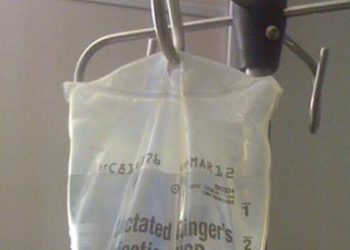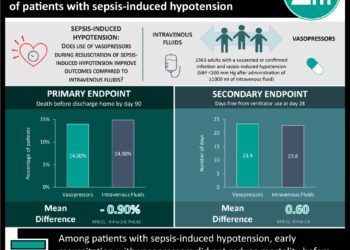Peripherally inserted central catheters are associated with twice as many complications than midline catheters when used short-term
1. This observational study found that peripherally inserted central catheters were associated with double the risk of a major complication (most commonly occlusion) and were four times more likely to get bloodstream infection than a midline catheter.
Evidence Rating Level: 2 (Good)
Study Rundown: Peripherally inserted central catheters (PICCs) are a type of central venous catheter inserted into a peripheral vein and ending in the cavoatrial junction near the right atrium. Because of their location, they are associated with several complications, including central line–associated bloodstream infection (CLABSI) and deep vein thrombosis (DVT). By contrast, catheter-related bloodstream infection (CRBSI) and DVT are less likely with midline catheters, which end at or below the axillary vein in the brachial, basilic, or cephalic veins. This study investigates the outcomes of patients who received PICCs versus midlines at many US centres in multiple states. 48 hospitals that were a part of the Hospital Medicine Safety Consortium collected data on the complications of PICCs and midlines inserted for difficult venous access or to give antibiotics. Complications included CLABSI or CRBSI, symptomatic upper extremity DVTs, pulmonary embolism (PE), and catheter occlusion that occurred within 30 days of insertion. PICCs were used more for antibiotics and longer duration while midlines were used more for difficult access and when the patient had a thromboembolism history in the study sample. More PICCs (N = 5758) than midlines (N = 5105) were associated with a complication (9.9% vs 3.9%), including catheter occlusion and CLABSI (compared to CRBSI). DVT and PE occurred equally in the two types of lines. The most common complication was catheter occlusion. Midlines were more slightly likely to be removed due to complications. When accounting for other factors, PICC, compared to a midline, were twice as likely to develop a major complication, twice as likely to develop occlusion, and four times as likely to cause bloodstream infections. A strength of this study it its sample size, as a large multi-centre comparison of PICC and midlines, which affords generalizability to the results. One of the limitations of this study is its observational design, which permits confounding error and cannot suggest causative conclusions. Additionally, there was no tracking of the device specific features, manufacturers, and coatings of the involved PICC and midlines, which may differ in quality and thus risk of complications.
Click to read the study in JAMA Internal Medicine
In-Depth [prospective cohort]: This multi-centre observational study collected PICC and midline complications in a representative sample of hospitalized general medicine ward or intensive care unit adult inpatients. Included patients received their PICC or midline for the indication of difficult venous access or intravenous (IV) antibiotics for <30 days. Patients were followed for their outcomes a maximum of 30 days. Pregnant patients or those under observation were excluded. 5758 PICCs and 5105 midlines were analyzed for this study (average age = 64.8 years, 52.8% female). More midlines were for difficult IV access or blood draws than PICCs (72.4% vs 40.1%), while PICCs were used more for antibiotics than midlines (72.4% vs 40.1%). PICCs stayed in longer, with a mean time in (dwell time) of 14 days compared to midlines that were in for an average of 6 days. Patients who received midlines were more likely to have a history of thromboembolism than those that got PICCs (6.7% vs 3.3%). More patients with a PICC experienced a major complication than those with a midline (9.9% vs 3.9%, standard mean deviation [SMD] = -0.237). Catheter occlusion, the most common complication, occurred more in PICCs than midlines (7.0% vs 2.1%, SMD = -0.240). CLABSI was more prevalent in PICCs than CRBSI was in midlines (1.6% vs 0.4%, SMD = -0.126). DVT occurred at nearly the same frequency in PICCs and midlines (1.5% vs 1.4%, SMD = -0.003). 0.2% of both patients receiving a PICC or those receiving a midline had a PE (SMD = −0.018). Interestingly, midlines were more likely to be removed for their complications than PICCs (7.3% vs 5.2%). In an analysis that adjusted for demographic characteristics and medical history, the patients who got a PICC, compared to a midline, were twice as likely to develop a major complication (OR = 1.99, 95% CI = 1.61-2.47), twice as likely to develop an occlusion (OR = 2.24, 95% CI = 1.70-2.96) and four times as likely to have bloodstream infection (OR = 4.44, 95% CI = 2.52-7.82) and equally likely to develop a DVT (OR = 0.93, 95% CI = 0.63-1.37) or PE (OR = 1.29, 95% CI = 0.46-3.61). These findings were consistent with the risks in the first 10 days of catheter insertion.
Image: PD
©2021 2 Minute Medicine, Inc. All rights reserved. No works may be reproduced without expressed written consent from 2 Minute Medicine, Inc. Inquire about licensing here. No article should be construed as medical advice and is not intended as such by the authors or by 2 Minute Medicine, Inc.





